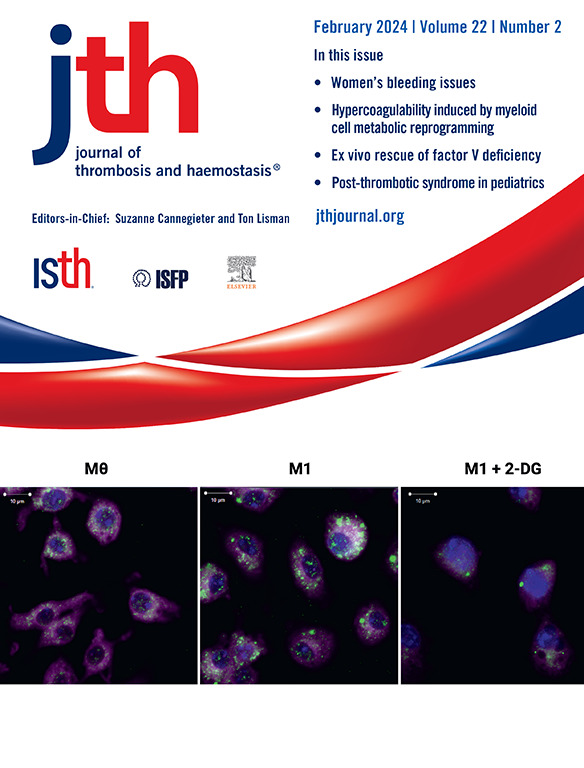循环生物标志物改善房颤卒中风险预测:cha2ds2 - vasc生物标志物模型
IF 5
2区 医学
Q1 HEMATOLOGY
引用次数: 0
摘要
背景:抗凝可减少房颤(AF)患者的缺血性卒中,但会增加出血。指导房颤抗凝决策的现有风险计算有很大的局限性。目的:确定普通人群卒中风险的生物标志物是否与房颤卒中风险相关,并提高CHA2DS2-VASc(充血性心力衰竭、高血压、年龄bbbb74、糖尿病、既往卒中或短暂性脑缺血发作或血栓栓塞、血管疾病、年龄65-74、性别分类)评分的预测性能。方法:卒中地理和种族差异的原因(REGARDS)是一项前瞻性队列研究,于2003年至2007年招募了30239名成年人,并对其进行了卒中监测。研究对象为房颤患者,未服用抗凝剂,既往无卒中史。在储存的基线样本中测量了9种循环生物标志物。Cox模型,调整了人口统计学和卒中危险因素,估计了每种生物标志物与卒中事件的关联。然后,使用拟合检验(似然比检验和Akaike信息准则)和风险判别检验(连续净重分类指数,[NRI>0 0])对单独使用CHA2DS2-VASc评分或添加生物标志物的模型进行比较。结果:在2411名AF患者(中位年龄69岁,55%女性,36%黑人)中,163名(7%)在13年内首次发生缺血性卒中。较高的n端前b型利钠肽、生长分化因子15、胱抑素C、白细胞介素6和脂蛋白(a)与较高的卒中风险独立相关。生物标志物显著改善了CHA2DS2-VASc模型的拟合(改变了Akaike信息标准-13,P < 0.001)和预测能力(5年NRI bb0 0 0.42)。与所有生物标志物相比,仅添加n端前b型利钠肽和生长分化因子15获得了最佳的模型拟合和相似的NRI bb0 0。结论:5项生物标志物与房颤卒中风险相关,其中2项可改善CHA2DS2-VASc表现。这种改进的cha2ds2 - vasc生物标志物评分可以更好地选择抗凝患者,以减少房颤卒中。本文章由计算机程序翻译,如有差异,请以英文原文为准。
Improving stroke risk prediction in atrial fibrillation with circulating biomarkers: the CHA2DS2-VASc–Biomarkers model
Background
Anticoagulation reduces ischemic stroke in atrial fibrillation (AF) but increases bleeding. Existing risk calculators guiding anticoagulation decisions in AF have substantial limitations.
Objectives
To determine whether biomarkers of stroke risk for general populations are associated with stroke risk in AF and improve predictive performance of the CHA2DS2-VASc (Congestive heart failure, Hypertension, Age >74, Diabetes, prior Stroke or transient ischemic attack or thromboembolism, Vascular disease, Age 65-74, Sex category) score.
Methods
The REasons for Geographic And Racial Differences in Stroke (REGARDS) is a prospective cohort study of 30 239 adults enrolled in 2003 to 2007 and monitored for stroke. Participants with AF not taking anticoagulants and with no prior stroke history were studied. Nine circulating biomarkers were measured in stored baseline samples. Cox models, adjusted for demographics and stroke risk factors estimated associations of each biomarker with incident stroke. Then, models with CHA2DS2-VASc score alone or adding biomarkers were compared using tests of fit (likelihood ratio test and Akaike information criterion) and risk discrimination (continuous net reclassification index, [NRI>0]).
Results
Among 2411 participants with AF (median age 69 years, 55% female, 36% Black), 163 (7%) developed first-time ischemic stroke over 13 years. Higher N-terminal pro-B-type natriuretic peptide, growth differentiation factor 15, cystatin C, interleukin 6, and lipoprotein (a) were independently associated with higher stroke risk. Biomarkers substantially improved CHA2DS2-VASc model fit (change in Akaike information criterion −13, P < .001) and predictive ability (5-year NRI>0 0.42). Adding only N-terminal pro-B-type natriuretic peptide and growth differentiation factor 15 yielded the best model fit and a similar NRI>0 compared with all biomarkers.
Conclusions
Five biomarkers were associated with stroke risk in AF, and 2 of these improved CHA2DS2-VASc performance. This improved CHA2DS2-VASc–Biomarkers score can allow better selection of patients for anticoagulation to reduce stroke in AF.
求助全文
通过发布文献求助,成功后即可免费获取论文全文。
去求助
来源期刊
CiteScore
24.30
自引率
3.80%
发文量
321
审稿时长
1 months
期刊介绍:
The Journal of Thrombosis and Haemostasis (JTH) serves as the official journal of the International Society on Thrombosis and Haemostasis. It is dedicated to advancing science related to thrombosis, bleeding disorders, and vascular biology through the dissemination and exchange of information and ideas within the global research community.
Types of Publications:
The journal publishes a variety of content, including:
Original research reports
State-of-the-art reviews
Brief reports
Case reports
Invited commentaries on publications in the Journal
Forum articles
Correspondence
Announcements
Scope of Contributions:
Editors invite contributions from both fundamental and clinical domains. These include:
Basic manuscripts on blood coagulation and fibrinolysis
Studies on proteins and reactions related to thrombosis and haemostasis
Research on blood platelets and their interactions with other biological systems, such as the vessel wall, blood cells, and invading organisms
Clinical manuscripts covering various topics including venous thrombosis, arterial disease, hemophilia, bleeding disorders, and platelet diseases
Clinical manuscripts may encompass etiology, diagnostics, prognosis, prevention, and treatment strategies.

 求助内容:
求助内容: 应助结果提醒方式:
应助结果提醒方式:


